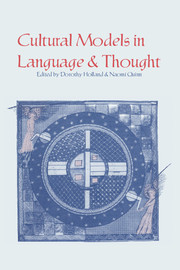Book contents
- Frontmatter
- Contents
- Preface
- List of Contributors
- Introduction
- Part I Presupposed worlds, language, and discourse
- 2 The definition of lie
- 3 Linguistic competence and folk theories of language
- 4 Prestige and intimacy
- 5 A folk model of the mind
- Part II Reasoning and problem solving from presupposed worlds
- Part III The role of metaphor and analogy in representing knowledge of presupposed worlds
- Part IV Negotiating social and psychological realities
- Part V An appraisal
- Index
3 - Linguistic competence and folk theories of language
Two English hedges
Published online by Cambridge University Press: 05 June 2012
- Frontmatter
- Contents
- Preface
- List of Contributors
- Introduction
- Part I Presupposed worlds, language, and discourse
- 2 The definition of lie
- 3 Linguistic competence and folk theories of language
- 4 Prestige and intimacy
- 5 A folk model of the mind
- Part II Reasoning and problem solving from presupposed worlds
- Part III The role of metaphor and analogy in representing knowledge of presupposed worlds
- Part IV Negotiating social and psychological realities
- Part V An appraisal
- Index
Summary
In the ordinary sense in which we say that words like chair and table are ABOUT furniture, hedges are words about language and speech. There is nothing remarkable in this; language is part of our environment, and we have words about most things in our environment. The linguistically interesting aspect of hedges is that, although they are about language, they are not exactly used to talk about language as we would say that chair and table are used to talk about furniture or, for example, gerund and entailment are used to talk about language. When we use a word like chair or table or gerund or entailment, chairs, tables, gerunds, and entailments do not become ipso facto part of what is said. With hedges it is different; when we use a hedge like loosely speaking, the notion of “loose speech” which this expression invokes becomes part of the combinatorial semantics of the sentence and utterance in which it occurs. A familiar (if probably vacuous) combinatorial semantic rule is
(SR) If adjective a denotes class A and noun n denotes class N, then the denotation of the expression an is the intersection of the classes A and N.
I wish to claim that the notion of “loose speech” is part of the combinatorial semantics of sentences containing the expression loosely speaking in the same way in which the notion of class intersection is claimed by proponents of (SR) to be part of the combinatorial semantics of an expression like red chair.
- Type
- Chapter
- Information
- Cultural Models in Language and Thought , pp. 67 - 77Publisher: Cambridge University PressPrint publication year: 1987
- 3
- Cited by



